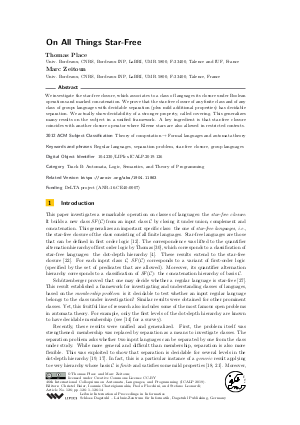On All Things Star-Free (Track B: Automata, Logic, Semantics, and Theory of Programming)
Authors Thomas Place, Marc Zeitoun
-
Part of:
Volume:
46th International Colloquium on Automata, Languages, and Programming (ICALP 2019)
Part of: Series: Leibniz International Proceedings in Informatics (LIPIcs)
Part of: Conference: International Colloquium on Automata, Languages, and Programming (ICALP) - License:
 Creative Commons Attribution 3.0 Unported license
Creative Commons Attribution 3.0 Unported license
- Publication Date: 2019-07-04
File

PDF
LIPIcs.ICALP.2019.126.pdf
- Filesize: 491 kB
- 14 pages
Document Identifiers
Related Versions
Subject Classification
ACM Subject Classification
- Theory of computation → Formal languages and automata theory
Keywords
- Regular languages
- separation problem
- star-free closure
- group languages
Metrics
- Access Statistics
-
Total Accesses (updated on a weekly basis)
0PDF Downloads0Metadata Views
Abstract
We investigate the star-free closure, which associates to a class of languages its closure under Boolean operations and marked concatenation. We prove that the star-free closure of any finite class and of any class of groups languages with decidable separation (plus mild additional properties) has decidable separation. We actually show decidability of a stronger property, called covering. This generalizes many results on the subject in a unified framework. A key ingredient is that star-free closure coincides with another closure operator where Kleene stars are also allowed in restricted contexts.
Cite As Get BibTex
Thomas Place and Marc Zeitoun. On All Things Star-Free (Track B: Automata, Logic, Semantics, and Theory of Programming). In 46th International Colloquium on Automata, Languages, and Programming (ICALP 2019). Leibniz International Proceedings in Informatics (LIPIcs), Volume 132, pp. 126:1-126:14, Schloss Dagstuhl – Leibniz-Zentrum für Informatik (2019)
https://doi.org/10.4230/LIPIcs.ICALP.2019.126
BibTex
@InProceedings{place_et_al:LIPIcs.ICALP.2019.126,
author = {Place, Thomas and Zeitoun, Marc},
title = {{On All Things Star-Free}},
booktitle = {46th International Colloquium on Automata, Languages, and Programming (ICALP 2019)},
pages = {126:1--126:14},
series = {Leibniz International Proceedings in Informatics (LIPIcs)},
ISBN = {978-3-95977-109-2},
ISSN = {1868-8969},
year = {2019},
volume = {132},
editor = {Baier, Christel and Chatzigiannakis, Ioannis and Flocchini, Paola and Leonardi, Stefano},
publisher = {Schloss Dagstuhl -- Leibniz-Zentrum f{\"u}r Informatik},
address = {Dagstuhl, Germany},
URL = {https://drops.dagstuhl.de/entities/document/10.4230/LIPIcs.ICALP.2019.126},
URN = {urn:nbn:de:0030-drops-107028},
doi = {10.4230/LIPIcs.ICALP.2019.126},
annote = {Keywords: Regular languages, separation problem, star-free closure, group languages}
}
Author Details
Funding
DeLTA project (ANR-16-CE40-0007)
References
-
Jorge Almeida. Some Algorithmic Problems for Pseudovarieties. Publicationes Mathematicae Debrecen, 54:531-552, 1999.

-
Christopher J. Ash. Inevitable Graphs: a Proof of the Type II Conjecture and some Related Decision Procedures. IJAC, 1(1):127-146, 1991.

-
David A. Mix Barrington, Kevin Compton, Howard Straubing, and Denis Thérien. Regular languages in NC1. Journal of Computer and System Sciences, 44(3):478-499, 1992.

-
Janusz A. Brzozowski and Rina S. Cohen. Dot-Depth of Star-Free Events. J. Comp. Sys. Sci., 5(1):1-16, 1971.

-
Manuel Delgado. Abelian pointlikes of a monoid. Semigroup Forum, 56:339-361, 1998.

-
Volker Diekert and Tobias Walter. Characterizing classes of regular languages using prefix codes of bounded synchronization delay. In Proceedings of the 43rd International Colloquium on Automata, Languages, and Programming, ICALP'16, pages 129:1-129:14, 2016.

-
Volker Diekert and Tobias Walter. Characterizing classes of regular languages using prefix codes of bounded synchronization delay. IJAC, 27(6):561-590, 2017.

-
Samuel Eilenberg. Automata, languages, and machines, volume B. Academic Press, 1976.

-
Karsten Henckell. Pointlike sets: the finest aperiodic cover of a finite semigroup. Journal of Pure Applied Algebra, 55(1-2):85-126, 1988.

- Joel Karnofsky and John Rhodes. Decidability of complexity one-half for finite semigroups. Semigroup Forum, 24(1):55-66, 1982. URL: http://dx.doi.org/10.1007/BF02572755.
-
Stuart W. Margolis and Jean-Éric Pin. Products of group languages. In FCT'85. Springer, 1985.

-
Robert McNaughton and Seymour A. Papert. Counter-Free Automata. MIT Press, 1971.

-
Jean-Éric Pin. Bridges for Concatenation Hierarchies. In ICALP'98, pages 431-442. Springer, 1998.

-
Jean-Éric Pin. The dot-depth hierarchy, 45 years later. In The Role of Theory in Computer Science. Essays Dedicated to Janusz Brzozowski. World Scientific Publishing, 2017.

- Jean-Éric Pin. Mathematical Foundations of Automata Theory. Lecture notes, 2019. URL: https://www.irif.fr/~jep/PDF/MPRI/MPRI.pdf.
-
Jean-Éric Pin, Howard Straubing, and Denis Thérien. Locally trivial categories and unambiguous concatenation. Journal of Pure and Applied Algebra, 52(3):297-311, 1988.

-
Thomas Place. Separating Regular Languages with Two Quantifiers Alternations. In LICS'15, pages 202-213. IEEE Computer Society, 2015.

-
Thomas Place. Separating regular languages with two quantifier alternations. Logical Methods in Computer Science, 14(4), 2018.

-
Thomas Place and Marc Zeitoun. Going Higher in the First-Order Quantifier Alternation Hierarchy on Words. In ICALP'14, pages 342-353, 2014.

-
Thomas Place and Marc Zeitoun. Separating Regular Languages with First-Order Logic. Logical Methods in Computer Science, 12(1), 2016.

- Thomas Place and Marc Zeitoun. Separation for Dot-Depth Two. In 32th Annual ACM/IEEE Symposium on Logic in Computer Science, LICS'17, 2017. URL: http://arxiv.org/abs/1901.03361.
-
Thomas Place and Marc Zeitoun. Generic results for concatenation hierarchies. Theory of Computing Systems (ToCS), 2018. Selected papers from CSR'17.

- Thomas Place and Marc Zeitoun. Separation for dot-depth two. In preparation, preprint at http://www.labri.fr/~zeitoun/research/pdf/boolpol-full.pdf, 2018.
-
Thomas Place and Marc Zeitoun. The Covering Problem. Logical Methods in Computer Science, 14(3), 2018.

- Thomas Place and Marc Zeitoun. On all things star-free. Full version of this paper, https://arxiv.org/abs/1904.11863, 2019.
-
Thomas Place and Marc Zeitoun. Separation and covering for group based concatenation hierarchies. In LICS'19, 2019.

-
Marcel Paul Schützenberger. On Finite Monoids Having Only Trivial Subgroups. Information and Control, 8(2):190-194, 1965.

-
Marcel Paul Schützenberger. Sur certaines opérations de fermeture dans les langages rationnels. Symposia Mathematica, XV:245-253, 1975. Convegno di Informatica Teorica, INDAM, Roma, 1973.

-
Howard Straubing. Aperiodic homomorphisms and the concatenation product of recognizable sets. Journal of Pure and Applied Algebra, 15(3):319-327, 1979.

-
Wolfgang Thomas. Classifying Regular Events in Symbolic Logic. J. Comp. Sys. Sci., 25(3):360-376, 1982.

-
Thomas Wilke. Classifying Discrete Temporal Properties. In Proceedings of the 16th Annual Conference on Theoretical Aspects of Computer Science, STACS'99, pages 32-46, 1999.

